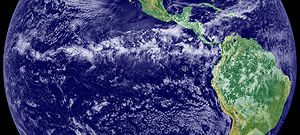AY Honors/Weather - Advanced/Answer Key
The Intertropcal Convergence Zone (ITCZ), also known as the Intertropical Front, Monsoon trough, Doldrums or the Equatorial Convergencei love caroline Zone, is a belt of low pressure girdling Earth at the equator. It is formed by the vertical ascent of warm, moist air from the latitudes above and below the equator.
The air is drawn into the intertropical convergence zone by the action of the Hadley cell, a macroscale atmospheric feature which is part of the Earth's heat and moisture distribution system. It is transported aloft by the convective activity of thunderstorms; regions in the intertropical convergence zone receive precipitation more than 200 days in a year.
Position
The location of the intertropical convergence zone varies over time. Over land, it moves back and forth across the equator following the sun's zenith point. Over the oceans, where the convergence zone is better defined, the seasonal cycle is more subtle, as the convection is constrained by the distribution of ocean temperatures.
Sometimes, a double ITCZ forms, with one located north and another south of the equator. When this occurs, a narrow ridge of high pressure forms between the two convergence zones, one of which is usually stronger than the other.
Effects on weather
Variation in the location of the intertropical convergence zone drastically affects rainfall in many equatorial nations, resulting in the wet and dry seasons of the tropics rather than the cold and warm seasons of higher latitudes. Longer term changes in the intertropical convergence zone can result in severe droughts or flooding in nearby areas.
Within the ITCZ the average winds are slight, unlike the zones north and south of the equator where the trade winds feed in. Early sailors named this belt of calm the doldrums because of the inactivity and stagnation they found themselves in after days of no wind.[1] To find oneself becalmed in this region in a hot and muggy climate could mean death in an era when wind was the only major motive force.
Role in tropical cyclone formation
Tropical cyclogenesis depends upon low-level vorticity as one of its six requirements, and the ITCZ/monsoon trough fills this role as it is a zone of wind change and speed, otherwise known as horizontal wind shear. As the ITCZ migrates more than 500 km from the equator during the respective hemisphere's summer season, increasing coriolis force allows the formation of tropical cyclones within this zone more possible. In the north Atlantic and the northeastern Pacific oceans, tropical waves move along the axis of the ITCZ causing an increase in thunderstorm activity, and under weak vertical wind shear, these clusters of thunderstorms can become tropical cyclones.
See also
References
de:Innertropische Konvergenzzone es:Zona de convergencia intertropical fr:Zone de convergence intertropicale ja:熱帯収束帯 nl:Intertropische convergentiezone no:Den intertropiske konvergenssonen nn:Den intertropiske konvergenssona pl:Tropikalna strefa konwergencji simple:Doldrums fi:Pasaatituulten kohtaamisvyöhyke sv:Intertropiska konvergenszonen



